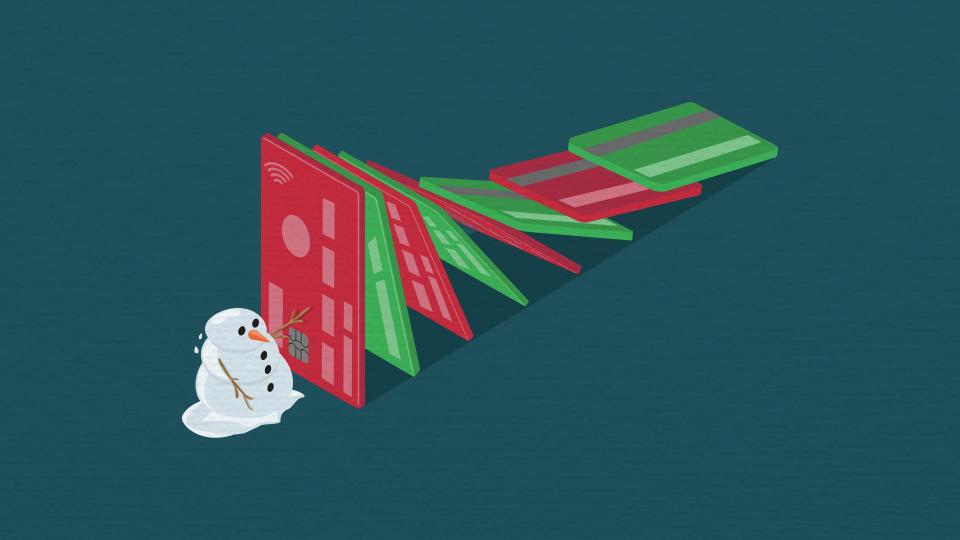Only half of Americans believe they can pay off their December credit card bill

Only half of America’s credit card customers believe they can pay off their December balance in full, according to an industry index, signaling a low ebb in “credit card confidence” as the nation emerges from the holidays.
The LendingTree Credit Card Confidence Index, a monthly survey published since 2018 by the personal finance site, dipped to 51% in December, an all-time low.
In a nationally representative survey of 1,514 cardholders, only 51% voiced confidence that they could pay off their card balance this month. In November, the Confidence Index stood at 58%.
If credit card confidence is slipping, many other industry metrics are moving in the opposite direction.
The national credit card balance stands at $1.08 trillion, a record high. The average interest rate has reached 21%, the highest point recorded by the Federal Reserve in nearly three decades of tracking. Some retail cards now charge upwards of 30%.
“It was hard to imagine that growing debt, rising inflation and sky-high interest rates weren’t eventually going to take a toll,” said Matt Schulz, chief credit analyst at LendingTree.
Credit cards are the fastest-rising category of household debt
LendingTree’s index joins a chorus of industry warnings about card debt. A periodic survey by Bankrate found that 47% of cardholders carried debt from month to month in mid-2023, up from 39% at the end of 2021.
The average card customer holds $6,088 in debt, according to a TransUnion report for the third quarter of 2023, up from $5,474 at the same time in 2022.
Credit card debt is rising faster than any other major category of household debt, according to a November report from Wells Fargo Economics.
“I think all this adds up to more people carrying more debt for longer periods of time, and unfortunately, I don’t see any of that reversing any time soon,” said Ted Rossman, a senior industry analyst at Bankrate.
LendingTree began tracking credit card confidence at an opportune moment. Card rates soared in 2022 and 2023 after hovering in the 12% to 15% range through several prior years. The rise mirrored a broader surge in borrowing rates set off by the Fed in a series of historic rate hikes, a campaign triggered, in turn, by rampant inflation.
Before December’s drop, the Credit Card Confidence Index had last hit bottom in June 2022, the month when the annual inflation rate hit a 40-year high of 9.1%. That month, only 53% of cardholders voiced confidence that they could pay off their balances.
The credit card index peaked at 74% confidence in October 2020, a moment of rock-bottom interest rates and federal stimulus relief. The index has gradually declined in every year since, to an annual average of about 66% in 2021, 62% in 2022 and 59% in 2023.
Women are more concerned than men about credit card debt
Women drove the recent plunge in the LendingTree index, with only 40% expressing confidence that they could pay off their card balance in December, compared to 64% of men.
That’s a big gap, but women have consistently voiced less confidence than men across the five years of the survey.
Schulz, the LendingTree analyst, theorizes that women may “take a little bit more conservative approach to their finances” than men.
“Men may be a little more confident than they should be,” he said, “while women may be a little bit less confident than they could be.”
Catherine Valega, a certified financial planner in Boston who specializes in the finances of women, opines that female consumers may be feeling stretched during the holidays because of their historic roles as gift-givers and domestic procurers.
“Women tend to want to give gifts, and they also tend to manage the stuff in their households,” Valega said. “Who doesn’t spend more at yearend?”
Industry analysts expect card rates to ease in 2024, particularly if the Fed follows through on its forecast of modest rate cuts in the new year.
But even a drop of two full points in average card rates would only bring them down to around 19%, still historically high.
“I’m not sure people would notice that much of a difference,” Rossman said.

Here are some tips for reducing credit card debt
What to do, then, if you are a credit card customer who suddenly finds yourself underwater?
Rossman suggests consumers with debt on a high-interest card consider transferring some or all of the balance onto a zero-APR card. Such cards typically set the monthly interest rate at zero for a span of 15 months or longer, allowing customers to focus their payments entirely on debt.
“If you use one of these properly, you can save a ton of money on interest,” Rossman said.
More: How to get out of credit card debt and remain debt free
Consumers with weaker credit scores, who may not qualify for a zero-APR offer, might consider a nonprofit such as the Consumer Credit Counseling Service. Credit counselors can intervene with the card company. “A lot of times, they can negotiate something like a 7- to 8% interest rate,” Rossman said.
Cardholders can also benefit from a few simple rules in using their cards, Valega said. One is to charge only as much as you can afford to repay that month. Another is to set up automatic payments on the card. Better still if you can select the option to auto-pay the entire balance at month’s end.
This article originally appeared on USA TODAY: Credit card debt rises as some struggle to pay off holiday spending